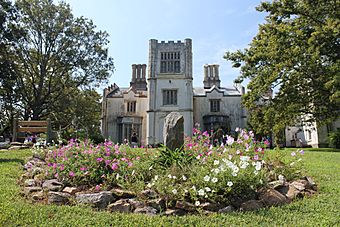Belmead (Powhatan, Virginia) facts for kids
|
Belmead
|
|

Belmead, September 2012
|
|
| Location | NW of jct. of Rtes. 663 and 600, near Powhatan, Virginia |
|---|---|
| Area | 0 acres (0 ha) |
| Built | c. 1845 |
| Architect | Davis, Alexander J. |
| Architectural style | Gothic, Gothic Villa |
| NRHP reference No. | 69000270 (original) 100011700 (increase) |
Quick facts for kids Significant dates |
|
| Added to NRHP | November 12, 1969 |
| Boundary increase | April 14, 2025 |
Belmead, also known as Belmead Plantation, is a historic estate located near Powhatan, Virginia. It was designed by a famous architect named Alexander Jackson Davis and built around 1845. This special place later became home to two important schools for African-American students.
Contents
History
The Early Years and Philip Cocke
Belmead was built in 1835 by Philip St. George Cocke. He came from a well-known family in Virginia. Philip had studied at the University of Virginia and the United States Military Academy. After serving briefly in the US Army, he focused on managing large farms in Virginia and Mississippi. Belmead was one of these farms.
Philip St. George Cocke and his wife, Sarah Elizabeth Courtney Bowdoin, had eleven children. Nine of their children were born at Belmead. During this time, many enslaved people were forced to work on the plantation. Records show that 82 enslaved people lived and worked at Belmead in 1840. This number grew to 124 by 1860. They performed various tasks on the farm, which grew tobacco and grain.
In 1861, Philip Cocke became a brigadier general for Virginia. He fought in the First Battle of Bull Run. Later that year, he returned to Belmead.
Important Schools for African-American Students
In 1897, the property was bought by the Sisters of the Blessed Sacrament. This group was led by Katharine Drexel, who later became a saint. In 1899, they opened St. Francis de Sales School at Belmead. This was a school just for African-American girls.
Soon after, Edward de Veaux Morrell and his wife Louise opened St. Emma Military Academy for boys on the same property. Louise was Katharine Drexel's half-sister. The boys' school was named after Katharine's stepmother. Together, these two schools helped educate about 15,000 African-American students over the years.
Belmead was recognized for its historical importance and added to the National Register of Historic Places in 1969. The schools at Belmead closed in the early 1970s.
Protecting Belmead's Future
In 2016, the Sisters of the Blessed Sacrament decided to sell the large 2,265-acre property. A group of former students and community members formed a nonprofit organization called Belmead on the James. They started a fundraising effort to help preserve the historic site.
In June 2019, the property was sold to Jeff Oakley for $6 million. He has since allowed alumni to organize tours and share the rich history of Belmead with more people.
Architecture
The main house at Belmead is a two-story building made of brick covered in stucco. It is built in the Gothic Revival style. This style was popular in the mid-1800s and often looks like old European castles or churches.
The house has a three-story section in the middle with a pointed roof. It also features a square tower with strong corner supports and decorative battlements along the top, called crenellation. The tower has special arched doorways at ground level and windows with diamond-shaped panes of glass. The roof has groups of round and many-sided chimneys. The kitchen building was later made part of a larger addition to the house when it became a school.



